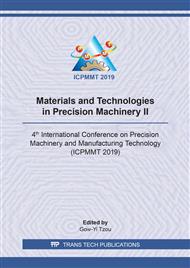p.53
p.59
p.69
p.77
p.85
p.93
p.101
p.107
p.113
Prediction of Grain Size during Hot Forging of SCR420HB Using a Phenomenological Model
Abstract:
The material constants of a phenomenological model for predicting the grain size evolution during hot deformation are determined using first and second stages of a hot forging process. The constants including initial grain size exponent, strain exponent, strain rate exponent and dynamic recrystallization activation energy for SCR420HB bearing steel were obtained through finite element optimization technique introduced by the same authors in literature. In the optimization, the error between the experimental and predicted grain sizes at some sample points were minimized by adjusting the material constants as the design variables. The predicted grain size after the third stage using the optimized material constants was compared with the experimental values to validate the obtained material constants. The comparison showed that the model predicts the grain size with tolerable error when the obtained material constants are applied.
Info:
Periodical:
Pages:
107-112
Citation:
Online since:
February 2020
Authors:
Keywords:
Price:
Сopyright:
© 2020 Trans Tech Publications Ltd. All Rights Reserved
Share:
Citation:


